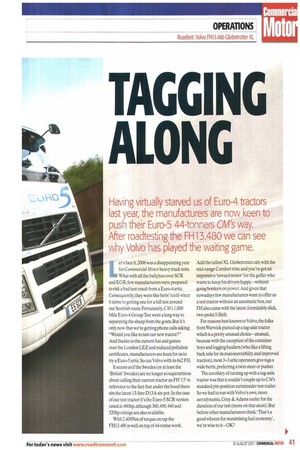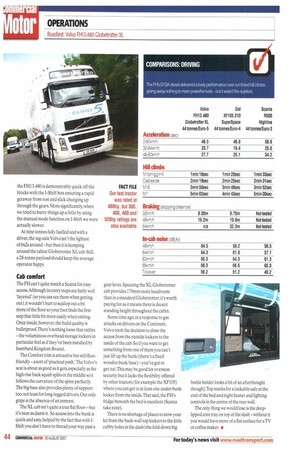TAGGING ALONG
Page 41

Page 42

Page 43

Page 44

If you've noticed an error in this article please click here to report it so we can fix it.
Having virtually starved us of Euro-4 tractors last year, the manufacturers are now keen to push their Euro-5 44-tonners CM'S way.
After roadtesting the FH13.480 we can see why Volvo has played the waiting game.
L, et's face it, 2006 was a disappointing year for Commercial Motor heavy truck tests. What with all the ballyhoo over SCR and EGR, few manufacturers were prepared to risk a bad test result from a Euro-4 artic. Consequently, they were like hens' teeth when it came to getting one for a full test around our Scottish route. Fortunately, CM 's 1,000 Mile Euro-4 Group Test went a long way to separating the sheep from the goats. But it's only now that we're getting phone calls asking: "Would you like to test our new tractor?" And thanks to the current fun and games over the London LEZ and reduced pollution certificates. manufacturers are keen for us to try a Euro-5 artic. So cue Volvo with its 6x2 FH.
It seems as if the Swedes (or at least the 'British' Swedes) are no longer so superstitious about calling their current tractor an FH '13' in reference to the fact that under the hood there sits the latest 13-litre D13A six-pot. In the case of our test tractor it's the Euro-5iSCR version rated at 480hp, although 360, 400,440 and 520hp ratings are also available.
With 2.400Nm of torque on tap the FH13.480 is well on top of 44-tonne work. Add the tallest XL Globetrotter cab, with the mid-range Comfort trim, and you've got an impressive 'reward motor' for the gaffer who wants to keep his drivers happy without going bonkers on power.And given that nowadays few manufacturers want to offer us a test tractor without an automatic box, our FH also came with the latest, formidably slick, two-pedal I-Shift.
For reasons best known to Volvo, the folks from Warwick punted up a tag-axle tractor which is a pretty unusual choice —unusual, because with the exception of the container boys and logging hauliers (who like a lifting back axle for its manoeuvrability and improved traction), most 3+3 artic operators give tags a wide berth, preferring a twin-steer or pusher.
The corollary of turning up with a tag-axle tractor was that it couldn't couple up to CM's standard pin-position curtainsider test trailer. So we had to run with Volvo's own, more aerodynamic, Gray &Adams reefer for the duration of our test (more on that anon). But before other manufacturers think: 'That's a good wheeze for maximising fuel economy', we're wise to it —OK? On the road When it comes to ride and handling there's something about tag-axle tractors we just can't put our finger on, except they do drive differently to a twin-steer or pusher. How differently naturally depends on the position of the fifth wheel, though there was the odd occasion when it did feel as if the tail was wagging the dog. Without spending more time in the FH we can't put it better than that, although it's nothing you can't get used to and we have no complaints about the Volvo's steering— which felt pretty positive.And for such a tall cab the XL Globetrotter has remarkably little cab sway even when pushed hard through a corner.
Talk to a driver with 385s on the front of their truck and they'll tell you they ride better over the ruts and tramlines in the motorway. Having had them on our artic we would buy that, but their wider footprint means you also end up feeling every lump and bump in the road— the ride of our FH felt somewhat 'taut'.
We've always felt that I-Shift`talks' well to Volvo's engines and the D13A is no exception. We continue to be impressed by how it shifts within a very tight rev band so you are seldom out of the 1,000-1,600rpm green band—and with the judicious use of your right foot you can force upshifts and help to save fuel, Although we used the manual mode quite a few times (to hold a gear when approaching the top of the hill,or to stay in top at 40mph), most of the time full auto is more than adequate. We just don't see the need for an economy/power mode any more (if you want more go there's always the kickdown), or all those different optional software programmes But despite those grumbles, I-Shift provides a wonderfully relaxed drive, helped by the Dl 3A's impressive lugging power. Even up steep motorway climbs such as Shap it held top gear, digging in atl ,100rpm and thumping away quite happily.
The long-haul/fuel economy programme on our I-Shift included the EcoRoll function which also works in conjunction with the Volvo Engine Brake (VEB),In the past we have found EcoRoll reluctant to engage on all but the flattest terrains but Volvo must have tweaked it because it cut in far more frequently on our test tractor. And when you reach a set speed in EcoRoll,VEB stops you running away with yourself.The good news is that when VEB cuts in, it doesn't knock out the cruise control so you have foot-off running uphill and down dalewhile always being in complete control.We like VEB, especially the way it is blended' into the footbrake and how I-Shift works with it to provide the best back pressure by selecting the optimum lowest gear (ie one that won't lift the head off).
In general the FH's control and instrument layout is fine. If we have one bone of contention it's this: why does Volvo go to such lengths to create a decent view from the driver's seat, only to clutter it up with an external sun visor (that wobbles), a high dash and enormous mirror clusters that block your sideways view? And as our FH didn't have the new easier-to-see-around mirrors, we can't say if things are any better on that last score.
Productivity
A few words on the FH13.480's fuel economy: that's more like it! Ever since the original Euro-1 FH12.420 delivered an astonishing 8.39mpg at 38 tonnes around CM s: old threeday Scottish route in 1994, we've struggled to get anywhere near it with subsequent FH tests. And frankly it has left us baffled. Indeed, when we drove the Euro-3 FH12.460 more than three years ago at 44 tonnes, complete with I-Shift and the identical Globetrotter XL cab, it barely managed more than 7mpg. So the Euro-5 FH13.480's impressive overall figure of 8.10mpg is most welcome—if somewhat overdue.
No doubt some readers will be saying: "But it had the advantage of Volvo's own box trailer, not CM'S curtainsider!"True, that didn't hurt, nor did the superb weather conditions (high temperatures and hardly a breath of wind). But equally Volvo didn't do itself any favours by fitting those wide-single 385 boots on the FH's front axle as opposed to more fuel-efficient 315 or 295s.
Thus any advantage Volvo might have had running with a more slippery trailer was partially offset by the 385s' increased rolling resistance (based on our own tests we estimate they have a negative impact on your mpg of 1.5-2%). Meanwhile, across both days and over our three special sections, the FH's fuel figures were consistently impressive.
As traffic volumes creep up and up it is getting harder and harder to get a really clear run on a CM test. Consequently the FH's somewhat pedestrian overall average speed of 70.0km/h is more a reflection of niggling delays on both days than any lack of go. Indeed, when it comes to hill-climb times and straight acceleration up to 80km/h the FH13.480 is demonstrably quick off the blocks with the I-Shift box ensuring a rapid getaway from rest and slick changing up through the gears. More significantly, when we tried to hurry things up a little by using the manual mode function on I-Shift we were actually slower.
At nine tonnes fully fuelled and with a driver, the tag-axle Volvo isn't the lightest of 6x2s aroundbut then it is humping around the tallest Globetrotter XL cab. Still, a 28-tonne payload should keep the average operator happy.
Cab comfort
The can't quite match a Scania for easy access.Although its entry steps are fairly well 'layered' (so you can see them when getting out), it wouldn't hurt to scallop out a bit more of the floor so your foot finds the first step that little bit more easily when exiting. Once inside, however, the build quality is bulletproof.There's nothing loose that rattles the voluminous overhead storage lockers in particular feel as if they've been installed by Isambard Kingdom Brunel.
The Comfort trim is attractive but still fleetfriendly a sort of 'practical posh.' The Volvo's seat is about as good as it gets, especially as the high-rise back squab splits in the middle so it follows the curvature of the spine perfectly. The big base also provides plenty of support too. not least for long-legged drivers. Our only gripe is the absence of an armrest.
The XL cab isn't quite a true flat floor—but it's near as damn it. So access into the bunk is quick and easy, helped by the fact that with!Shift you don't have to thread your way past a gear lever. Speccing the XL Globetrotter cab provides 170mm more headroom than in a standard Globetrotter: it's worth paying for as it means there is decent standing height throughout the cabin.
Some time ago, in a response to gas attacks on drivers on the Continent, Volvo took the decision to close the access from the outside lockers to the inside of the cab. So if you want to get something from one of them you can't just lift up the bunk (there's a fixed wooden bunk base) you've got to get out.This may be good for overseas security but it lacks the flexibility offered by other tractors (for example the XF105) where you can get to at least one under-bunk locker from the inside.That said, the FH's fridge beneath the bed is excellent (Scania take note).
There is no shortage of places to stow your kit from the back-wall top lockers to the little cubby holes in the dash (the fold-down big bottle holder looks a bit of an afterthought though).Top marks for a lockable safe at the end of the bed and night heater and lighting controls in the centre of the rear wall.
The only thing we would lose is the deeplipped coin tray on top of the dash-without it you would have more of a flat surface for a TV or coffee maker..






















































































































































































